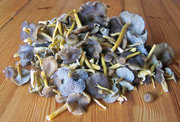| Chanterelle |
| |
| Scientific
classification |
| |
| Species |
| C. cibarius
C. cinereus
C. cinnabarinus
C.
craterellus
C. formosus
C. lateritius
C. lutescens
C.
minor
C. pallens
C. persicinus
C. subalbidus
C.
tabernensis
C. tubaeformis
C. xanthopus
|
Cantharellus
is a genus with many delicious and popular edible mushrooms. It is
a mycorrhizal edible fungus, meaning it
forms symbiotic associations with
plants, making it very
challenging to cultivate. Caution must be
used when identifying chanterelles for consumption; lookalikes, such as the Jack-O-Lantern,
can make a person very ill. Still, the yellow chanterelle is one of the most recognized
edible mushrooms and can be found in Asia, Europe, North America and Australia.
Synonyms
and common names
- C.
cibarius
- yellow
chanterelle, chanterelle
- C.
subalbidus
- white
chanterelle
- C.
formosus
- Pacific
golden chanterelle
- C.
tubaeformis
- funnel
chanterelle, yellow foot, winter mushroom
Species
The
best known species of this genus is the yellow chanterelle[1] , which is orange or yellow, meaty and funnel-shaped. It has forking gills on the underside,
running all the way down its stalk, which tapers down seamlessly from the cap.
It has a fruity smell and a peppery taste, and is considered an excellent food
mushroom.
In California and the Pacific
Northwest of USA there is also the white
chanterelle[2] , which looks like the yellow except for its off-white
color. It is more fragile and found in lesser numbers than the yellow chanterelle,
but can otherwise be treated as its yellow cousin.
The
Pacific golden chanterelle, C. formosus, has recently been recognized as
a separate species from the yellow chanterelle. It forms a mycorrhizal association
with the Douglas-fir and Sitka spruce
forests of the Pacific Northwest.
This chanterelle has been designated Oregon's state mushroom, due to
its economic value and abundance.

Cleaned
funnel chanterelles The
yellow foot[3]) is a yellowish-brown and trumpet-shaped chanterelle
found in great numbers late in the mushroom season, thus earning the common name
winter mushroom. The cap is convex and sometimes hollow down the middle,
and because of this it is also known as funnel chanterelle. The gills are
widely separated, and of lighter color than the cap. It grows on moss or rotten wood, and is an excellent food mushroom,
especially fried or in soups.
Use
in food
Chanterelles
in general go well with eggs, chicken, pork and veal, can be used as toppings on
pizzas, be stewed, marinated,
fried in butter, or used as
filling for stuffed pancakes. Of course these are
just examples; chanterelles are versatile and can be added as an ingredient to
most dishes.
Preparation
and storage
Since
the mushrooms hold a lot of water, a good way of preparing them
is to "dry sauté" them: after cleaning, the mushrooms are sliced and put in a
pan over medium heat. When covered in the water they've released, they are removed
from the heat and frozen in their own water. Alternatively,
the water can be used in sauces or simply discarded.
Chanterelles
can also be pickled in brine. Salted water is brought to
the boil, and pickling spices such as peppercorns, mustard
seeds, and thyme are added. The mushrooms are
then cooked in this solution for 5–10 minutes before being transferred to sterilized
bottles along with some of the liquid. Sliced garlic and dill can be added to the bottles
for extra flavour. The remaining liquid forms an excellent stock
for making soup. When
pickled in this way, chanterelles can last from six to twelve months.
Another
storage technique is drying. The chanterelles
are dried in open air and then stored without a lid. A few hours before final
preparation the mushrooms are put in water which they absorb and return to practically
their original size. They can then be used as fresh.
Fresh
chanterelles can generally be stored up to ten days in a refrigerator.
Notes
The
species with the common name black chanterelle[4]
is, as its Latin name implies, not of the Cantharellus genus, and thus
not really a chanterelle. It is sometimes called the trumpet of death,
though it is in fact a delicious mushroom, and not poisonous. It is hard to find
because of its liking for dark and sheltered places.
Similar
species
The false
chanterelle (Hygrophoropsis aurantiaca) has finer, more orange gills
and a darker cap. It is edible, but typically a culinary disappointment. The very
similar Jack-O-Lantern mushroom (Omphalotus illudens) and its sister species
(Omphalotus olivascens) are very poisonous, though not lethal. They have
true gills (unlike chanterelles) which are thinner, have distinct crowns, and
generally do not reach up to the edge. Additionally, the Jack-O-Lantern mushroom
is bioluminescent.

